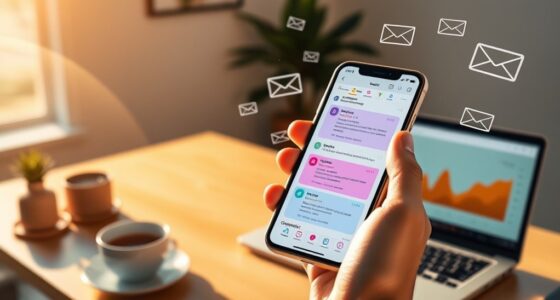Email marketing helps you simultaneously boost retention and attract new customers. You can reward loyal clients with personalized offers, exclusive discounts, and early access to build long-term relationships. At the same time, targeted campaigns and lead magnets draw in prospects, turning them into customers. Balancing these strategies creates steady growth and a loyal base. Keep exploring how combining retention and acquisition through email can transform your business success.
Key Takeaways
- Email marketing strengthens customer retention through personalized offers, exclusive discounts, and ongoing engagement.
- It attracts new leads with targeted campaigns, lead magnets, and incentives to support acquisition efforts.
- Automated email sequences nurture prospects, building trust and guiding them toward long-term loyalty.
- Loyalty programs delivered via email encourage repeat purchases and reduce churn, boosting retention.
- Combining retention and acquisition strategies via email creates a sustainable growth cycle and enhances overall customer lifetime value.

Have you ever wondered whether focusing on retaining existing customers is more beneficial than constantly chasing new ones? It’s a question many marketers grapple with, and the answer often depends on how effectively you leverage your email marketing strategy. When it comes to customer retention, loyalty programs play an essential role. They reward repeat business and make your customers feel valued, encouraging them to stay engaged. Email is a perfect tool to promote these programs—sending personalized offers, exclusive discounts, or early access to sales makes your customers feel special. This not only strengthens their loyalty but also increases the likelihood they’ll choose your brand over competitors.
Loyalty programs reward customers and boost engagement through personalized email offers and exclusive discounts.
But retention isn’t just about rewards. Lead nurturing through email is equally important. By consistently providing valuable content—such as helpful tips, updates, or tailored recommendations—you nurture your relationship with your audience. This ongoing communication keeps your brand top of mind and helps you build trust over time. When customers feel appreciated and understood, they’re more likely to remain loyal and less tempted to switch to competitors. Email campaigns can be automated to deliver the right message at the right time, making lead nurturing both efficient and effective. For example, you can send a welcome series to new subscribers, check-in emails after a purchase, or re-engagement campaigns for inactive customers. These touchpoints show you care about their experience and encourage continued interaction. Additionally, understanding the role of motivation can help craft more compelling messages that resonate with your audience’s desires.
On the other hand, acquisition efforts often focus on reaching new audiences through targeted email campaigns. You might use lead magnets or sign-up incentives to attract fresh leads, then nurture those leads with personalized content designed to convert them into customers. While acquisition can bring in new revenue, it’s often more costly and less sustainable than customer retention. That’s why many businesses find that investing in email strategies that promote loyalty programs and lead nurturing delivers a higher return on investment. These methods help turn one-time buyers into repeat customers who generate consistent revenue over time.
Ultimately, both retention and acquisition are essential, but email marketing provides a seamless way to support both goals simultaneously. By emphasizing loyalty programs and lead nurturing, you create a cycle where existing customers feel appreciated and new leads are gradually turned into loyal patrons. This balanced approach ensures your business grows steadily, with a loyal customer base that’s less vulnerable to market changes. In the end, your email strategy becomes the backbone of a sustainable customer relationship, proving that nurturing what you already have often yields better results than constantly chasing new prospects.
Frequently Asked Questions
How Does Email Personalization Impact Customer Loyalty?
Email personalization boosts customer loyalty by making your messages more relevant and engaging. Using personalization strategies like addressing recipients by name and tailoring content to their preferences encourages deeper connections. You can implement customer engagement techniques such as targeted offers or personalized recommendations, which show you understand their needs. This approach fosters trust, encourages repeat business, and strengthens loyalty, ultimately turning casual buyers into loyal advocates of your brand.
What Metrics Best Measure Email’s Role in Acquisition?
You should focus on open rates, click-through rates, and conversion rates to measure email’s role in acquisition. Segmentation strategies help target the right audience, increasing engagement, while A/B testing optimizes subject lines, content, and calls-to-action. Tracking these metrics reveals how well your emails attract new customers, allowing you to refine your campaigns for better results and higher acquisition success.
Can Email Campaigns Effectively Re-Engage Dormant Customers?
Yes, email campaigns can effectively re-engage dormant customers by leveraging loyalty programs and engagement triggers. You can send targeted offers or exclusive rewards to reignite their interest, encouraging repeat business. Personalization based on past interactions helps, too. By consistently monitoring engagement metrics, you’ll identify the most effective triggers and tailor your messages, ultimately turning inactive customers back into loyal, active ones.
How Often Should Businesses Send Retention-Focused Emails?
Think of your retention emails like watering a plant—you want to do it regularly but not overdo it. Usually, sending 1-2 targeted emails weekly works well, especially if you use segmentation strategies to personalize content. This keeps your brand top-of-mind without overwhelming the inbox. Aim for consistent, valuable communication to improve inbox placement and nurture long-term relationships. Adjust frequency based on engagement metrics to find your sweet spot.
What Are the Costs Associated With Email Retention Strategies?
You should conduct a cost analysis to understand the expenses of your email retention strategies. Costs include email platform fees, content creation, personalization, and analytics tools. Budget allocation is essential; allocate funds wisely to maximize ROI without overspending. By tracking these costs, you can optimize your campaigns, ensuring your retention efforts stay effective and sustainable while avoiding unnecessary expenses.
Conclusion
By mastering email marketing, you won’t just keep customers—you’ll hold onto them so tightly they’ll feel like they’re glued to your brand forever. Imagine turning every new subscriber into a lifelong fan, making your competitors wish they’d never heard of you. With the right strategies, your email game could become so unstoppable that even the biggest brands will bow down in awe. Get ready to conquer both retention and acquisition like a marketing legend!









